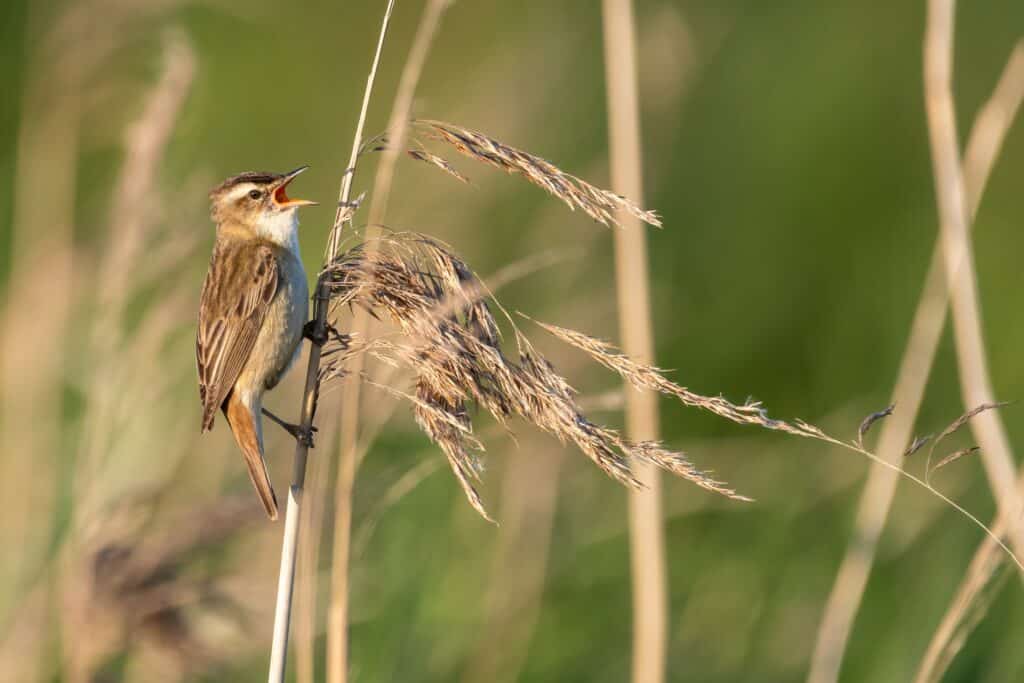Sedge Warbler
Acrocephalus schoenobaenus
Males never sing the same song twice
Advertisement
Sedge Warbler Scientific Classification
- Kingdom
- Animalia
- Phylum
- Chordata
- Class
- Aves
- Order
- Passeriformes
- Family
- Acrocephalidae
- Genus
- Acrocephalus
- Scientific Name
- Acrocephalus schoenobaenus
Read our Complete Guide to Classification of Animals.
Sedge Warbler Conservation Status
Sedge Warbler Facts
- Prey
- They eat insects like aphids, moths, beetles, spiders, and slugs
- Name Of Young
- Chicks
- Group Behavior
- Social
- Pair
- Fun Fact
- Males never sing the same song twice
- Estimated Population Size
- 12 to 22 million
- Biggest Threat
- Drought
- Most Distinctive Feature
- Complex songs
- Distinctive Feature
- Brown and black streaked plumage
- Wingspan
- 6 to 10 inches
- Incubation Period
- 13 to 15 days
- Age Of Independence
- 3 to 4 weeks
- Age Of Fledgling
- 11 to 12 days
- Habitat
- wet grasslands and lowland rainforests
- Diet for this Fish
- Insectivore
- Lifestyle
- Diurnal
- Type
- Bird
- Common Name
- Sedge warbler
- Special Features
- strong, pointed bill
- Location
- Europe, Africa, Western Asia
- Nesting Location
- In reed beds near water
- Migratory
- 1
View all of the Sedge Warbler images!
Their songs can mimic other species.
The sedge warbler is a medium-sized bird with complex songs and interesting mating behavior. They have an extensive range that covers three continents and migrates long distances to their breeding and wintering grounds. Discover everything there is to know about this warbler, including where they live, how they mate, and how to identify them.
5 Amazing Sedge Warbler Facts
- The oldest recorded sedge warbler was a banded warbler caught in Finland, reaching ten years and one month.
- Males never sing the same song twice. Females choose their mates based on who has the most complex phrases.
- Sedge warblers have an enormous population and an extensive range spanning over 100 countries on three continents.
- This species is usually monogamous, but some males participate in a polygamous lifestyle and mate with many females.
- They feed at dawn and dusk when the weather is cooler, thus immobilizing much of their insect prey.
Where to Find the Sedge Warbler
The sedge warbler inhabits over 100 countries in Europe, Africa, and Asia, from Finland to Siberia, down to Botswana and South Africa. These long-distance migrants have an enormous range, spending their springs and summers throughout Europe and Western Asia before migrating to their wintering homes in most parts of Africa. They breed in lowlands and valleys in cooler regions near water, and in winter, you can find them in wet grasslands and lowland rain forests. However, you can occasionally spot them in the drier brush, thickets, or desert scrub. Studies in Nigeria and Uganda suggest these birds return yearly to the same wintering grounds. Look for these birds perched on reeds and listen for their unusual and complicated songs.
Locations
- Europe
- All of Africa, except the southwestern tip
- Western Asia
Sedge Warbler Nest
Females build their nest near water in vegetation, such as reed beds and sedge marshes, typically on the ground. She forms a cup-shaped structure with an outer layer of grass, stems, weeds, and spider webs. She lines the inside with a thick layer of reed flowers, animal hair, and plant down.
Scientific Name
The sedge warbler (Acrocephalus Schoenobaenus) is from the Acrocephalidae family, which consists of singing perching birds, such as reed, marsh, and acrocephalid warblers. Their genus, Acrocephalus, is Ancient Greek for “highest head,” but “sharp-pointed” may be the proper translation. Its specific name, Schoenobaenus, is also Ancient Greek and means “reed” and “to tread.” The sedge warbler has no recognized subspecies.
Size, Appearance, and Behavior
This species is a medium-sized warbler, measuring 4.5 to 5.1 inches long and weighing around 0.42 ounces. Their wingspan is 6 to 10 inches. Both adult sexes have the same brown plumage with heavily streaked backs and paler undersides. It has a flattened forehead and black streaks on its crown with a strong, pointed bill. Juveniles have dark spots on their breast. The average lifespan is only two years, but they’ve been known to live as long as ten years.
Males arrive at their breeding grounds two weeks before the females to select their territories. During courting, males perform elaborate flight displays and singing. Females choose their mates based on their complex song phrases. Males never sing the same tune twice, and females appreciate an extensive repertoire. Their tunes can also mimic other species. The sedge warbler is usually monogamous, but there are also polygamous individuals who mate with many females. Males are often more social before they form pair bonds.

Both male and female adult sedge warblers have the same brown plumage.
©Alex Cooper Photography/Shutterstock.com
Migration Pattern and Timing
Sedge warblers are long-distance migrants. They spend their springs and summers in Europe and Western Asia, as far north as Scandinavia and Siberia. It flies south during migration to winter in Sub Saharan Africa, as far south as the eastern coast of South Africa. They reach their wintering grounds from mid-September to December, depending on how far south they travel. They are back on their breeding grounds from mid-March to early May.
Diet
Sedge warblers are primarily insectivorous but may supplement their diet with berries.
What Does the Sedge Warbler Eat?
The sedge warbler eats aphids, moths, beetles, spiders, slugs, snails, worms, grasshoppers, flies, and insect larvae. It will consume berries, such as elderberry and blackberry, in its wintering habitats. On the African continent, it’s known for eating flowers and other fruits. Before migration, they will double their fat reserves for nonstop flights. They feed at dawn and dusk in low, dense vegetation, where they pick insects from plants. Sometimes you can observe them hovering or “leap-catching” flying insects.
Predators, Threats, and Conservation Status
The IUCN lists the sedge warbler as LC or “least concern.” Due to its extensive range and vast, stable population, this species does not qualify for “threatened” status. However, they had a significant decline in their West African wintering quarters from severe drought in the past. The effects of global warming may change their population size in the future.
What Eats the Sedge Warbler?
Not much is known about the sedge warbler’s predators, but they may have similar threats as other warblers. Their possible predators include squirrels, raccoons, foxes, weasels, crows, jays, and snakes. They’ve also been witnessed performing alarm calls against doves, cuckoos, and sparrowhawks.
Reproduction, Young, and Molting
The breeding season begins in the spring, and egg laying begins in late April to mid-May, depending on the region. The female lays five to six light green eggs with olive markings. She incubates them by herself for 13 to 15 days, but both parents help with feeding duties. The young leave the nest 11 to 12 days after hatching but won’t be entirely independent for another two to three weeks. They have an average lifespan of two years but can live as long as ten.
Population
The sedge warbler’s global estimated population is between 12 million and 22 million mature individuals. Europe contains 60% of its worldwide range and estimates its breeding population to be between 3.8 and 6.5 million pairs. The IUCN suggests their current population trend is stable with no extreme fluctuations.
Up Next:
View all 293 animals that start with SSedge Warbler FAQs (Frequently Asked Questions)
Where do sedge warblers live?
They breed in lowlands and valleys in cooler regions near water, and in winter, you can find them in wet grasslands and lowland rainforests.
Where do sedge warblers nest?
Females build their nest near water in vegetation, such as reed beds and sedge marshes, typically on the ground.
What does a sedge warbler eat?
The sedge warbler eats aphids, moths, beetles, spiders, slugs, snails, worms, grasshoppers, flies, and insect larvae.
Do sedge warblers migrate?
Sedge warblers are long-distance migrants. They spend their springs and summers in Europe and Western Asia and winter in Sub-Saharan Africa.
How big are sedge warblers?
This species is a medium-sized warbler, measuring 4.5 to 5.1 inches long and weighing around 0.42 ounces.
Are sedge warblers endangered?
The IUCN lists the sedge warbler as LC or “least concern.” However, they are vulnerable to droughts.
How many eggs do sedge warblers lay?
The female lays five to six light green eggs with olive markings.
Thank you for reading! Have some feedback for us? Contact the AZ Animals editorial team.
Sources
- IUCN Red List / Accessed September 8, 2022
- British Birds / Accessed September 8, 2022
- Science Direct / Accessed September 8, 2022


















